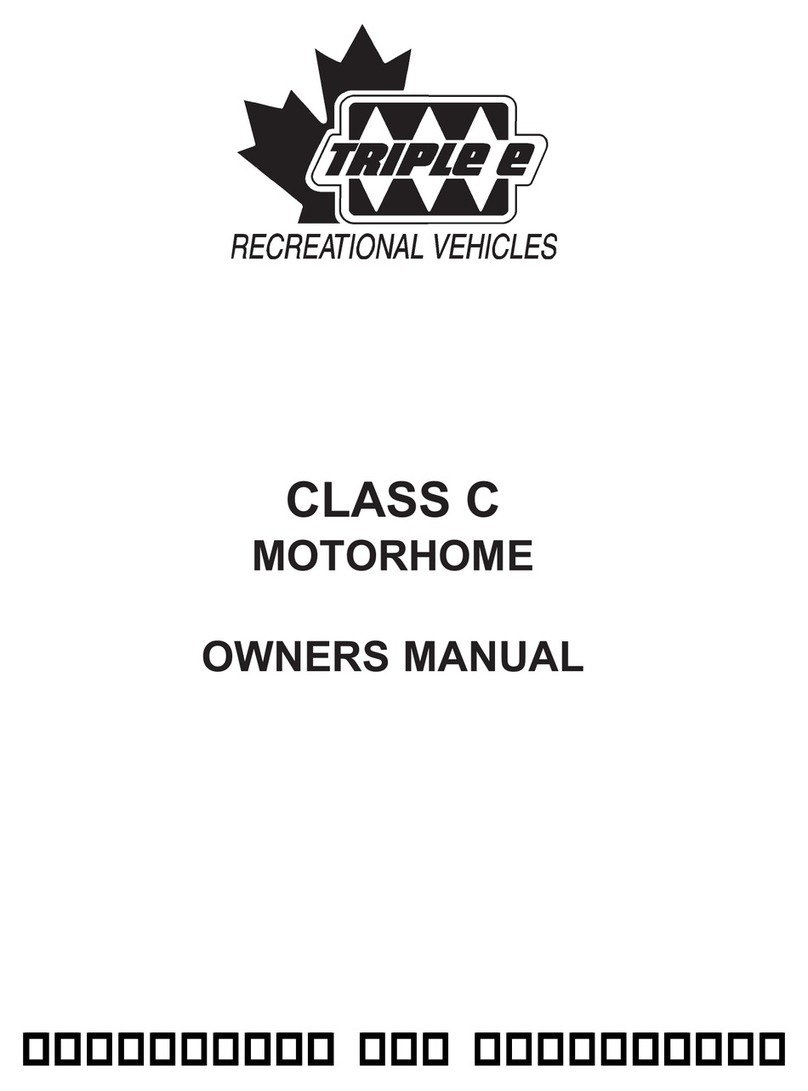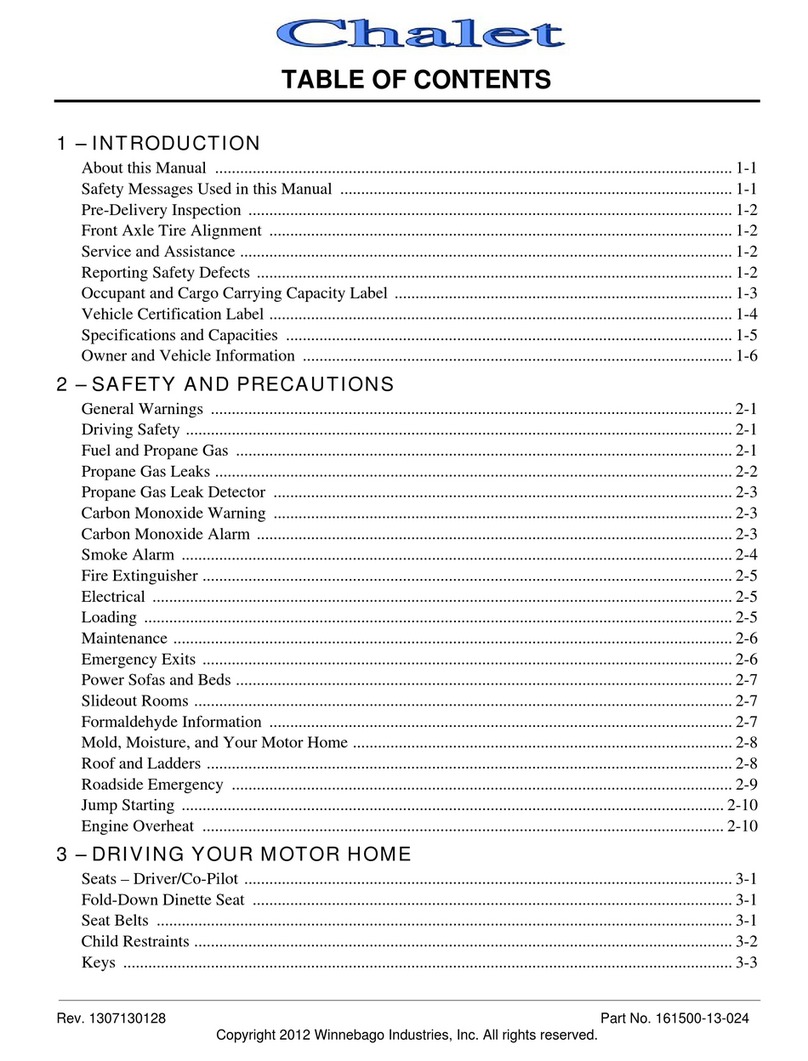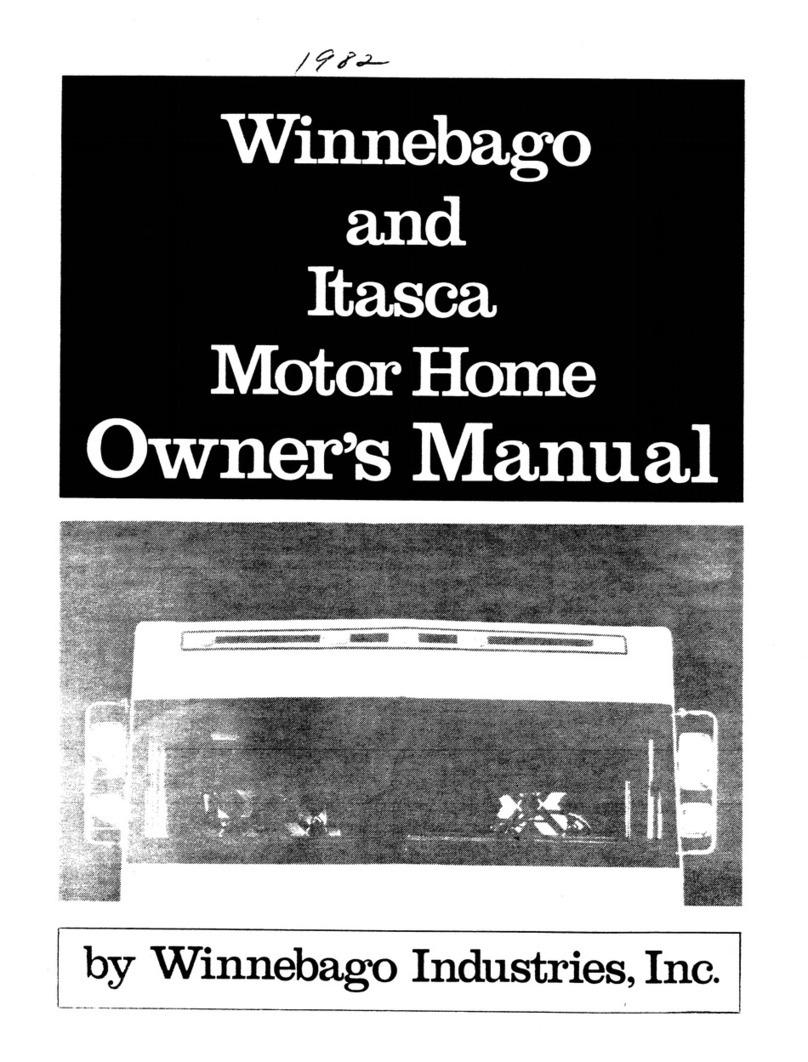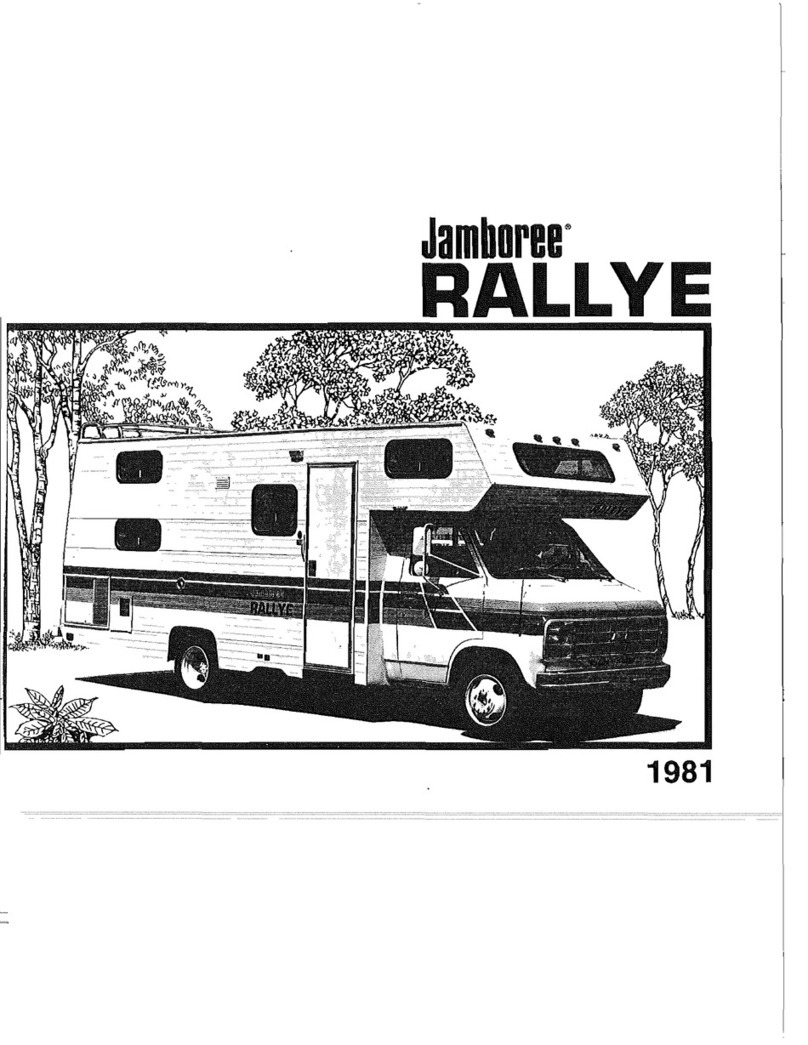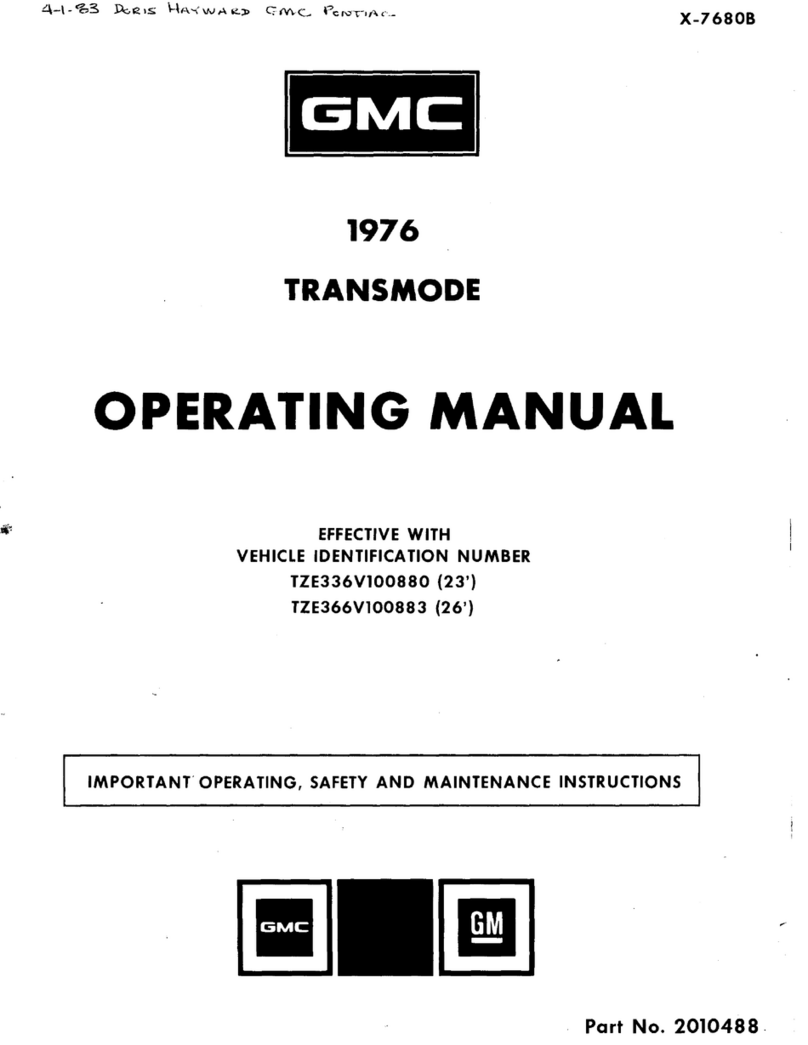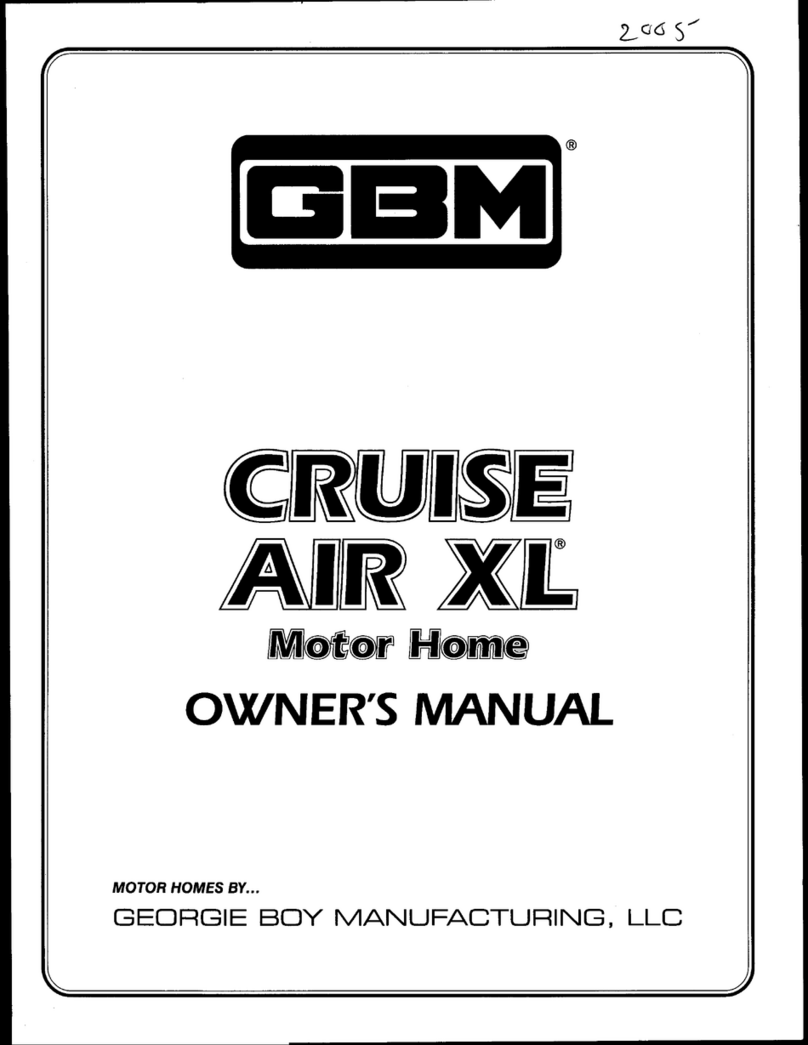Integrity Enclosed Trailer User manual

1
Enclosed Trailer
Owner’s Manual
^WARNING
This Owner’s Manual contains safety
information and instructions for your
trailer.
You must read this manual before loading
or towing your trailer.
You must follow all safety precautions and
instructions.
Bumper Pull Trailers
April 2011
Integrity Trailers, Inc.
50 Enterprise Drive
Carbondale, PA 18407

2
1. Introduction........................................................................................... 5
2. Safety .................................................................................................... 6
2.1 Safety Alert Symbols And Signal Words .......................................................6
2.2 Major Hazards ...................................................................................................6
2.2.1 Improper Sizing Of Trailer To Tow Vehicle ................................................................. 6
2.2.2 Driving Too Fast............................................................................................................ 6
2.2.3 Adjust Driving When Towing Trailer ........................................................................... 7
2.2.4 Trailer Not Properly Coupled To Hitch........................................................................ 7
2.2.5 Proper Use Of Safety Chains....................................................................................... 8
2.2.6 Proper Connection Of Breakaway Brake.................................................................... 8
2.2.7 Matching Trailer And Hitch.......................................................................................... 8
2.2.8 Worn Tires, Loose Wheels And Lug Nuts .................................................................. 8
2.2.9 Improper Loading ........................................................................................................ 9
2.2.10 Unsafe Load Distribution......................................................................................... 10
2.2.11 Shifting Cargo........................................................................................................... 10
2.2.12 Inappropriate Cargo ................................................................................................ 10
2.2.13 Inoperable Brakes Or Lights.....................................................................................11
2.2.14 Trailer Modifications..................................................................................................11
2.2.15 Trailer Towing Guide .................................................................................................11
2.2.16 Safe Trailer Towing Guidelines................................................................................ 12
2.2.17 Safety Warning Labels On Your Trailer................................................................... 13
2.2.18 Reporting Safety Defects......................................................................................... 16
3. Tire Safety Information ...................................................................... 17
3.1 Trailer Tire Information..................................................................................17
3.2 Steps For Determining Correct Load Limit - Trailer ...................................18
3.2.1 Trailers 10,000 Pounds GVWR Or Less.................................................................... 18
3.2.2 Trailers Over 10,000 Pounds GVWR ........................................................................ 18
3.3 Steps For Determining Correct Load Limit - Tow Vehicle..........................19
3.4 Glossary Of Tire Terminology.......................................................................19
3.5 Tire Safety - Everything Rides On It.............................................................21
3.5.1 Safety First- Basic Tire Maintenance........................................................................ 22
3.5.2 Finding Your Vehicle’s Recommended Tire Pressure And Load Limits................ 22
3.5.3 Understanding Tire Pressure And Load Limits ....................................................... 22
3.5.4 Safety First- Basic Tire Maintenance........................................................................ 22
3.5.5 Steps For Maintaining Proper Tire Pressure............................................................ 22
3.5.6 Tire Size....................................................................................................................... 23
3.5.7 Tire Tread..................................................................................................................... 23
3.5.8 Tire Balance And Wheel Alignment .......................................................................... 23
3.5.9 Tire Repair................................................................................................................... 23
3.5.10 Tire Fundamentals.................................................................................................... 23
3.5.10.1 Information on Passenger Vehicle Tires........................................................ 23
3.5.10.2 UTQGS Information......................................................................................................24
3.5.10.3 Additional Information On Light Truck Tires.............................................................25
3.5.10.4 Tire Safety Tips.............................................................................................................25
Contents

3
4. Coupling To Tow Vehicle ................................................................... 26
4.1 Tow Vehicle And Hitch...................................................................................26
4.1.1 Trailer Information...................................................................................................... 26
4.1.2 Tow Vehicle ................................................................................................................. 26
4.2 Coupling And Uncoupling The Trailer .........................................................26
4.3 Couple Trailer To Tow Vehicle ......................................................................27
4.3.1 Ball Hitch Coupler.......................................................................................................27
4.3.1.1 Before Coupling Trailer To Tow Vehicle........................................................... 28
4.3.1.2 Prepare Coupler And Hitch ............................................................................... 28
4.3.1.3 Couple Trailer To Tow Vehicle........................................................................... 28
4.3.2 Trailer With Ring And Pintle Coupler ....................................................................... 29
4.3.2.1 Before Coupling Trailer To Tow Vehicle........................................................... 29
4.3.2.2 Prepare Ring And Pintle .................................................................................... 29
4.3.2.3 Couple Trailer To Tow Vehicle........................................................................... 30
4.3.3 Connect Safety Chains............................................................................................... 30
4.3.4 Connect Electrical Cable............................................................................................ 31
4.3.5 Attach Breakaway Brake Lanyard............................................................................. 31
4.3.5.1 Test Electric Brakes........................................................................................... 31
4.3.5.2 Test Electric Breakaway Brakes ....................................................................... 31
4.3.5.3 Test Surge Brakes (If Equipped)....................................................................... 32
4.3.5.4 Test Surge Breakaway System ......................................................................... 33
4.4 Uncouple Trailer.............................................................................................33
4.5 Tongue Weight ...............................................................................................33
4.5.1 Checking Tongue Weight........................................................................................... 35
4.6 Adjust Hitch Height (If Equipped).................................................................35
5. Loading And Unloading..................................................................... 36
5.1 Loading Trailer...............................................................................................36
5.1.1 Preparing Trailer For Loading.................................................................................... 36
5.1.2 Loading Trailer............................................................................................................ 37
5.2 Unload Trailer.................................................................................................37
5.3 Securing Cargo..............................................................................................38
6. Pre-Tow Checklist............................................................................... 39
6.1 Pre-Tow Checklist..........................................................................................39
6.2 Make Regular Stops ......................................................................................39
7. Breaking In A New Trailer .................................................................. 40
7.1 Retighten Lugs At First 10, 25 & 50 Miles....................................................40
7.2 Adjust Brake At First 200 Miles ....................................................................40
7.3 Synchronizing Brake Systems .....................................................................40
Contents

4
8. Accessories ........................................................................................ 41
8.1 Accessory Battery .........................................................................................41
9. Inspection, Service And Maintenance.............................................. 42
9.1 Inspection, Service & Maintenance Summary Charts................................42
9.2 Inspection And Service Instructions............................................................45
9.2.1 Trailer Structure.......................................................................................................... 45
9.2.1.1 Fasteners And Frame Members........................................................................ 45
9.2.1.2 Welds................................................................................................................... 45
9.2.2 Trailer Brakes - Electric.............................................................................................. 45
9.2.2.1 Brake Shoes And Drums ................................................................................... 45
9.2.2.2 Manually Adjusting Brake Shoes...................................................................... 46
9.2.2.3 Electric Brakes ................................................................................................... 46
9.2.2.4 Tow Vehicle Operated Electric Brakes ............................................................. 46
9.2.2.5 Electric Brake Magnets...................................................................................... 46
9.2.3 Trailer Brakes - Surge (If Equipped).......................................................................... 46
9.2.3.1 Surge Brake Master Cylinder............................................................................ 46
9.2.3.2 Hydraulic Surge Brake....................................................................................... 46
9.2.3.3 Master Cylinder Bleeding.................................................................................. 47
9.2.4 Trailer Connection To Tow Vehicle............................................................................ 47
9.2.4.1 Coupler And Ball ................................................................................................ 47
9.2.4.2 Ring And Pintle................................................................................................... 48
9.2.5 Landing Leg Or Jack.................................................................................................. 48
9.2.6 Lights And Signals ..................................................................................................... 48
9.2.7 Wheel Rims ................................................................................................................. 48
9.2.8 Tires.............................................................................................................................. 48
9.2.9 Wheel Bearings........................................................................................................... 49
9.2.10 Lubrication................................................................................................................ 49
9.2.11 Lug Nuts Or Bolts..................................................................................................... 49
9.2.12 Inspect Drop Ramp Cables (If Equipped)............................................................... 50

5
1. Introduction
Congratulations on the purchase of your trailer. We
believe you will be happy and completely satisfied
with your purchase. Our goal is to provide a valued
customer a quality trailer at a reasonable price.
For your safety, read and understand this manual
before operating your trailer. If there are any questions
about information in this manual, please consult your
dealer.
When calling about your trailer, please have the VIN
number available for the dealer. The VIN number is
normally on the front left side of the trailer.
For future reference, please write your VIN number in
the space below:
___________________________________________
This manual covers the basic trailer. You must read,
understand and follow the instructions given by the
trailer manufacturer, tow vehicle and trailer hitch
manufacturers. Keep all manuals provided with your
trailer in a safe place at all times.
Inserts providing information on axles and tire
warranty are provided with this manual. Please keep
these inserts for future reference.
Introduction

6
2. Safety
2.1 Safety Alert Symbols And Signal
Words
An Owner’s Manual that provides general trailer
information cannot cover all of the specific details
necessary for the proper combination of every trailer,
tow vehicle and hitch. You must read, understand and
follow the instructions given by the tow vehicle and
trailer hitch manufacturers, as well as the instructions
in this manual.
Our trailers are built with components produced by
various manufacturers. Some of these items have
separate instruction manuals. Where this manual
indicates that you should read another manual, and
you do not have that manual, contact your dealer for
assistance.
The safety information in this manual is denoted by
the safety alert symbol:
^
This symbol means ATTENTION! BECOMEALERT!
YOUR SAFETY IS INVOLVED!
The level of risk is indicated by the following signal
words:
^DANGER
DANGER - Indicates a hazardous situation,
which, if not avoided, WILL result in death
or serious injury.
^WARNING
WARNING - Indicates a hazardous
situation, which, if not avoided, could
result in death or serious injury.
^CAUTION
CAUTION - Indicates a hazardous situation,
which, if not avoided, could result in minor
or moderate injury.
NOTICE
NOTICE - Indicates a situation that could
result in damage to the equipment or other
property.
2.2 Major Hazards
Loss of control of the trailer or trailer/tow vehicle
combination can result in death or serious injury. The
most common causes for loss of control of the trailer
are:
• Improper sizing the trailer for the tow vehicle, or
vice versa.
• Excessive Speed: Driving too fast for the
conditions.
• Improper braking and steering under sway
conditions
• Overloading and/or improper weight distribution.
• Not keeping lug nuts tight.
• Failure to adjust driving behavior when towing a
trailer.
• Not maintaining proper tire pressure
• Improper or mis-coupling of the trailer to the hitch.
2.2.1 Improper Sizing Of Trailer To Tow Vehicle
Trailers that weigh too much for the tow vehicle can
cause stability problems, which can lead to death
or serious injury. The additional strain put on the
engine and drive-train may lead to serious tow vehicle
maintenance problems.
Do not exceed the maximum towing capacity of your
tow vehicle. The towing capacity of your tow vehicle,
in terms of maximum Gross Trailer Weight (GTW) and
maximum Gross Combined Weight Rating (GCWR)
can be found in the tow vehicle Owner’s Manual.
^DANGER
Use of an under-rated hitch, ball or tow
vehicle can result in loss of control leading
to death or serious injury.
Make certain your hitch and tow vehicle
are rated for your trailer.
2.2.2 Driving Too Fast
With ideal road conditions, the maximum
recommended speed for safely towing a trailer is 55
mph. Driving too fast can cause the trailer to sway,
Safety

7
thus increasing the possibility for loss of control. Also
your tires may overheat, increasing the possibility of a
blowout.
^WARNING
Driving too fast for conditions can result in
loss of control and cause death or serious
injury.
Adjust speed down when towing trailer.
2.2.3 Adjust Driving When Towing Trailer
When towing a trailer, you will have decreased
acceleration, increased stopping distance, and
increased turning radius.
The trailer will change the handling characteristics of
the tow vehicle, making it more sensitive to steering
inputs and more likely to be pushed around in windy
conditions or when being passed by large vehicles. In
addition, you will need a longer distance to pass, due
to slower acceleration and increased length. With this
in mind:
• When encountering trailer sway, take your foot
off the accelerator, and steer as little as possible
in order to stay on the road. Use small “trim-like”
steering adjustments. Do not attempt to steer out
of the sway; you’ll only make it worse. Also do
not apply the tow vehicle brakes to correct trailer
swaying. On the other hand, application of the
trailer brakes alone will tend to straighten out the
combination, especially when going downhill.
• Check rearview mirrors frequently to observe
trailer and traffic.
• Be aware of trailer height, especially when
approaching bridges, roofed areas and trees.
• Be alert for slippery conditions. You are more
likely to be affected by slippery road surfaces
when driving a tow vehicle with a trailer, than
driving a tow vehicle without a trailer.
• Anticipate the trailer “swaying.” Swaying can
be caused by excessive steering, wind gusts,
roadway edges, or by the trailer reaction to the
pressure wave created by passing trucks and
busses.
• Use lower gear when driving down steep or
long grades. Use the engine and transmission
as a brake. Do not ride the brakes, as they can
overheat and become ineffective.
2.2.4 Trailer Not Properly Coupled To Hitch
It is critical that the trailer be securely coupled to
the hitch, and that the safety chains and emergency
breakaway brake lanyard are correctly attached.
Uncoupling may result in death or serious injury to
you and to others.
^WARNING
Proper selection and condition of the
coupler and hitch are essential to safely
towing a trailer.
A loss of coupling may result in death or
serious injury.
Hitch size must match coupler size.
Be sure hitch load rating is equal to or
greater than load rating of the coupler.
Be sure hitch components are tight before
coupling trailer to tow vehicle.
Observe hitch for wear, corrosion and
cracks before coupling. Replace worn,
corroded or cracked hitch components
before coupling trailer to tow vehicle.
^WARNING
An improperly coupled trailer can result in
death or serious injury. Do not move the
trailer until:
• Coupler is secured and locked to hitch.
• Safety chains are secured to tow
vehicle.
• Trailer jack(s) are fully retracted.
• Trailer brakes are checked.
• Tires and wheels are checked.
• Breakaway switch is connected to tow
vehicle;
• The trailer lights are connected and
checked.
• Load is secured to trailer.
Safety

8
2.2.5 Proper Use Of Safety Chains
Safety chains are provided so that control of the
trailer can be maintained if your trailer comes loose
from the hitch.
^WARNING
Improper rigging of the safety chains can
result in loss of control of the trailer and
tow vehicle, leading to death or serious
injury, if the trailer uncouples from the tow
vehicle.
Cross chains underneath hitch and coupler
with enough slack to permit turning and to
hold tongue up, if the trailer comes loose.
Fasten chains to frame of tow vehicle.
Do not fasten chains to any part of the
hitch unless the hitch has holes or loops
specifically for that purpose.
2.2.6 Proper Connection Of Breakaway Brake
If equipped with brakes, your trailer will be equipped
with a breakaway brake system that can apply the
brakes on your trailer if your trailer comes loose from
the hitch. You may have a separate set of instructions
for the breakaway brake if the trailer is so equipped. The
breakaway brake system, including battery, must be in
good condition and properly rigged to be effective.
^WARNING
An ineffective or inoperative breakaway
brake system can result in a runaway
trailer, leading to death or serious injury if
the coupler or hitch fails.
Breakaway lanyard must be connected
to the tow vehicle, NOT to any part of the
hitch.
Before towing trailer, test the function
of the breakaway brake system. If the
breakaway brake system is not working,
do not tow the trailer. Have it serviced or
repaired.
2.2.7 Matching Trailer And Hitch
^DANGER
Be sure hitch and tow vehicle are rated for
the Gross Vehicle Weight Rating (GVWR)
of your trailer.
Use of a hitch with a load rating less than
the load rating of the trailer can result in
loss of control and may lead to death or
serious injury.
Use of a tow vehicle with a towing capacity
less than the load rating of the trailer can
result in loss of control, and may lead to
death or serious injury.
2.2.8 Worn Tires, Loose Wheels And Lug Nuts
Inspect all trailer tires before each tow. If a tire has a
bald spot, bulge, cut, cracks, or is showing any cords,
replace the tire before towing.
If a tire has uneven tread wear, take the trailer
to a trailer service center for diagnosis. Uneven
tread wear can be caused by tire imbalance, axle
misalignment or incorrect inflation.
Tires with too little tread will not provide adequate
frictional forces on wet roadways and can result in
loss of control, leading to death or serious injury.
Improper tire pressure causes increased tire wear
and may reduce trailer stability, which can result in
a tire blowout or possible loss of control. Therefore,
before each tow you must also check the tire
pressure.
The proper tire pressure is listed on the Certification
/ VIN label, normally mounted on the front left side of
the trailer, and should be checked when tires are cold.
Allow 3 hours cool-down after driving as much as 1
mile at 40 mph before checking tire pressure.
Safety

9
^WARNING
Inflate tires to pressure stated on the
Certification / VIN label.
Improper tire pressure may cause unstable
trailer. Blowout and loss of control may
occur. Death or serious injury can result.
Make sure of proper tire pressure before
towing trailer.
The tightness of the wheel nuts or bolts is very
important in keeping the wheels properly seated to
the hub. Before each tow, check to make sure they
are tight.
^WARNING
Metal creep between the wheel rim and
wheel nuts or bolts may cause rim to
loosen.
Death or injury can occur if wheel comes
off.
Tighten lug nuts or bolts before each tow.
The proper tightness (torque) for wheel nuts or bolts
and tightening sequence is listed in the Inspection,
Service and Maintenance section of this manual. Use
a torque wrench to tighten the lug nuts and use the
crisscross star pattern sequence. Improper tightening
of the lug nuts voids the axle warranty.
Wheel nuts or bolts are also prone to loosen after first
being assembled. When driving a new trailer (or after
wheels have been remounted), check to make sure
they are tight after the first 10, 25 and 50 miles of
driving and before each tow thereafter.
Failure to perform this check can result in a wheel
separating from the trailer and a crash, leading to
death or serious injury.
^WARNING
Wheel nuts or bolts are prone to loosen
after being first assembled. Death or
serious injury can result.
Check wheel nuts or bolts for tightness
on a new trailer, and after re-mounting a
wheel at 10, 25 and 50 miles.
^WARNING
Inadequate wheel nut or bolt torque can
cause a wheel to separate from the trailer,
leading to death or serious injury.
Verify wheel nuts or bolts are tight before
each tow.
2.2.9 Improper Loading
The total weight of the load you put on the trailer, plus
the empty weight of the trailer itself, must not exceed
the trailer’s Gross Vehicle Weight Rating (GVWR).
If you do not know the empty weight of the trailer plus
the cargo weight, you must weigh the loaded trailer at
a commercial scale. In addition, you must distribute
the load in the trailer such that the load on any axle
does not exceed the Gross Axle Weight Rating
(GAWR).
If your trailer is equipped with a Tire & Loading
Information Placard, mounted next to the Certification/
VIN label, the cargo capacity weight stated on that
placard is only a close estimate. The GVWR and
GAWR are listed on the Certification/VIN label
normally located on the front left side of the trailer.
^WARNING
An overloaded trailer can result in failure
or loss of control of the trailer, leading to
death or serious injury.
Never load a trailer so that the weight on
any tire exceeds its rating.
Never exceed the trailer Gross Vehicle
Weight Rating (GVWR) or axle Gross Axle
Weight Rating (GAWR).
Safety

10
2.2.10 Unsafe Load Distribution
Improper front/rear load distribution can lead to an
unstable trailer or poor tow vehicle handling. Poor
trailer stability results from tongue weights that are
too low, and poor tow vehicle stability results from
tongue weights that are too high.
Refer to the “Loading And Unloading” section for
more information.
In the following table, the second column shows
the rule of thumb percentage of total weight of the
trailer plus its cargo (Gross Trailer Weight, or “GTW”)
that should appear on the tongue of the trailer. For
example, a large trailer with a loaded weight of 6,000
pounds, should have 10-15% of 6,000 pounds (600-
900 lbs.) on the hitch.
Tongue Weight as a Percentage of Loaded Trailer
Weight
Type of Hitch Percentage
Ball Hitch or
Ring & Pintle 10-15% for large trailers
6-10% for small trailers
The numbers quoted are for example purposes only
and should be tailored to the specific trailer.
For questions regarding the actual percent of tongue
weight for the trailer, check with the manufacturer
for specifics.
After loading, be sure to check that none of the axles
are overloaded.
Uneven left/right load distribution can cause tire,
wheel, axle or structural failure.
Be sure your trailer is evenly loaded left/right. Towing
stability also depends on keeping the center of gravity
as low as possible.
^WARNING
Improper tongue weight (load distribution)
can result in loss of control of the trailer,
leading to death or serious injury.
Make certain that tongue weight is within
the allowable range.
Be sure to:
• Distribute the load evenly, right and left.
• Keep the center of gravity low.
• Distribute the load front-to-rear to provide
proper tongue weight (see chart).
2.2.11 Shifting Cargo
Since the trailer “ride” can be bumpy and rough, you
must secure the cargo so that it does not shift while
the trailer is being towed.
^WARNING
A shifting load can result in failure, or to
loss of control of the trailer, and can lead
to death or serious injury.
You must tie down all loads with proper
sized fasteners, chains, straps, etc. to
prevent the load from shifting while
towing.
2.2.12 Inappropriate Cargo
The trailer may be designed for specific cargo. If
your trailer is designed for specific cargo, only carry
that cargo in the trailer.A trailer must not be used
to carry certain items, such as people, containers of
hazardous substances or containers of flammable
substances. A trailer not designed with a living
quarters must only be used for transportation of its
intended cargo.
^WARNING
Do not transport people in your trailer.
Besides putting their lives at risk, the
transport of people in a trailer is illegal.
Safety

11
^WARNING
Do not transport flammable, explosive,
poisonous or other dangerous materials
on your trailer.
The exception is fuel in the tank of a
vehicle or equipment being hauled.
^DANGER
You can die or be brain damaged by
Carbon Monoxide.
Do not operate a generator, portable grills,
portable heaters, portable lanterns or
portable stoves inside the trailer.
^WARNING
Never transport people in your trailer.
Besides putting their lives at risk, the
transport of people in a trailer is illegal.
^WARNING
Do not sleep in a trailer not equipped with
living quarters.
A trailer not designed with living quarters
must only be used for transportation of its
intended cargo.
^WARNING
Do not haul livestock or horses in an
enclosed trailer.
Use a trailer designed to haul livestock or
horses.
2.2.13 Inoperable Brakes Or Lights
If your trailer has electric brakes, your tow vehicle will
have an electric brake controller that sends power to
the trailer brakes.
Before towing the trailer, you must operate the brake
controller while trying to pull the trailer in order to
confirm that the electric brakes operate. While towing
the trailer at less than 5 mph, manually operate the
electric brake controller in the tow vehicle cab. You
should feel the operation of the trailer brakes.
If your trailer has hydraulic “surge” brakes, pull the
emergency breakaway brake lanyard to check the
operation of the surge mechanism.
Be sure that the electric brakes and all of the lights
on your trailer are functioning properly before towing
the trailer. Electric brakes and lights on a trailer
are controlled via a connection to the tow vehicle,
generally a multi-pin electrical connector.
^WARNING
Improper electrical connection between
the tow vehicle and the trailer will result in
inoperable lights and electric brakes, and
can lead to collision.
Before each tow:
• Check that the electric brakes work by
operating the brake controller inside the
tow vehicle.
• Check that all lights and turn signals
work.
You must provide mirrors that allow you to safely
observe approaching traffic. Standard mirrors usually
do not provide adequate visibility for viewing traffic to
the sides and rear a towed trailer.
2.2.14 Trailer Modifications
Modification of the trailer structure or alteration of
your trailer can make the trailer unsafe and will void
all warranty options. Before making any alteration to
the trailer, contact your dealer or the manufacturer
and describe the alteration you are contemplating.
2.2.15 Trailer Towing Guide
Driving a vehicle with a trailer in tow is vastly different
from driving the same vehicle without a trailer in tow.
Acceleration, maneuverability and braking are all
diminished with a trailer in tow. It takes longer to get
up to speed; you need more room to turn and pass,
and more distance to stop when towing a trailer.
You will need to spend time adjusting to the different
feel and maneuverability of the tow vehicle with a
loaded trailer. Because of the significant differences
in all aspects of maneuverability when towing a trailer,
Safety

12
the hazards and risks of injury are also much greater
than when driving without a trailer.
You are responsible for keeping your vehicle and
trailer in control, and for all the damage that is caused
if you lose control of your vehicle and trailer.
Find an open area with little or no traffic for your first
practice. Before you start towing the trailer, you must
follow all of the instructions for inspection, testing,
loading and coupling. Also, before you start towing,
adjust the mirrors so you can see the trailer as well as
the area to the rear of it.
Drive slowly at first, 5 mph or so, and turn the wheel
to get the feel of how the tow vehicle and trailer
combination responds. Next, make some right and left
hand turns. Watch in your side mirrors to see how the
trailer follows the tow vehicle. Turning with a trailer
attached requires more room.
Stop the rig a few times from speeds no greater than
10 mph. If your trailer is equipped with brakes, try
using different combinations of trailer/electric brake
and tow vehicle brake. Note the effect that the trailer
brakes have when they are the only brakes used.
When properly adjusted, the trailer brakes will come
on just before the tow vehicle brakes.
It will take practice to learn how to back up a tow
vehicle with a trailer attached. Take it slow. Before
backing up, get out of the tow vehicle and look behind
the trailer to make sure that there are no obstacles.
Some drivers place their hands at the bottom of
the steering wheel, and while the tow vehicle is in
reverse, “think” of the hands as being on the top
of the wheel. When the hands move to the right
(counter-clockwise, as you would do to turn the tow
vehicle to the left when moving forward), the rear of
the trailer moves to the right.
Conversely, rotating the steering wheel clockwise
with your hands at the bottom of the wheel will move
the rear of the trailer to the left, while backing up.
Be careful not to allow the trailer to turn too much,
because it will hit the rear of the tow vehicle. To
straighten the rig, either pull forward, or turn the
steering wheel in the opposite direction.
2.2.16 Safe Trailer Towing Guidelines
Before towing, check coupling, safety chain, brakes,
tires, wheels and lights.
Check the lug nuts or bolts for tightness.
Recheck the load tie downs to make sure the load will
not shift during towing.
Check coupler tightness after towing 50 miles.
Adjust the brake controller to engage the trailer
brakes before the tow vehicle brakes. Follow the
brake controller manufacturer’s literature.
Use your mirrors to verify that you have room to
change lanes or pull into traffic.
Use your turn signals well in advance.
Allow plenty of stopping space for your trailer and tow
vehicle.
Use lower gears for climbing and descending grades.
Do not ride the brakes while descending grades; they
may get so hot that they stop working. Then you will
potentially have a runaway tow vehicle and trailer.
Do not apply the tow vehicle brakes to correct
extreme trailer swaying. Instead, lightly apply the
trailer brakes with the hand controller.
Make regular stops, about once each hour. Confirm
that:
• The coupler is secure to the hitch and is locked.
• Electrical connectors are made.
• There is appropriate slack in safety chains.
• There is appropriate slack in breakaway lanyard.
• The tires are not visibly low on pressure.
• The cargo is secure and in good condition.
Slow down for bumps in the road.
Do not brake while in a curve unless absolutely
necessary. Instead, slow down before you enter the
curve.
Do not drive so fast that the trailer begins to sway due
to speed. Generally never drive faster than 55 m.p.h.
Allow plenty of room for passing. A rule of thumb is
that the passing distance with a trailer is 4 times the
passing distance without a trailer.
Safety

13
2.2.17 Safety Warning Labels On Your Trailer
Depending on trailer configuration, your trailer may not be equipped with all safety labels shown.
Safety

14
Safety

15
^WARNING
To protect you and others against death or
serious injury, all applicable labels shown
must be on the trailer and must be legible.
If any of these labels are missing or
cannot be read, contact your dealer for
replacement labels.

16
2.2.18 Reporting Safety Defects
If you believe that your vehicle has a defect that
could cause a crash or could cause injury or death,
you should immediately inform the National Highway
Traffic Safety Administration (NHTSA) in addition to
notifying
Integrity Trailers, Inc.
If NHTSA receives similar complaints, it may open
an investigation, and if it finds that a safety defect
exists in a group of vehicles, it may order a recall and
remedy campaign. However, NHTSA cannot become
involved in individual problems between you, your
dealer, or
Integrity Trailers, Inc.
To contact NHTSA, you may call the Vehicle Safety
Hotline toll-free at 1-888-327-4236 (TTY: 1-800-424-
9153); or go to http://www.safercar.gov; or write to:
Administrator, NHTSA,
1200 New Jersey SE,
Washington, DC 20590.
You can also obtain other information about motor
vehicle safety from http://www.safercar.gov.

17
3. Tire Safety Information
This portion of the User’s Manual contains tire safety
information as required by 49 CFR 575.6.
Section 3.1 contains “Trailer Tire Information”.
Section 3.2 contains “Steps for Determining Correct
Load Limit - Trailer”.
Section 3.3 contains “Steps for Determining Correct
Load Limit – Tow Vehicle”.
Section 3.4 contains a Glossary of Tire Terminology,
including “cold inflation pressure”, “maximum inflation
pressure”, “recommended inflation pressure”, and
other non-technical terms.
Section 3.5 contains information from the NHTSA
brochure entitled “Tire Safety – Everything Rides On
It”.
This brochure, as well as preceding subsections,
describes the following items;
• Tire labeling, including a description and explanation
of each marking on the tires, and information about
the DOT Tire Identification Number (TIN).
• Recommended tire inflation pressure, including a
description and explanation of:
A. Cold inflation pressure.
B. Vehicle Placard and location on the vehicle.
C. Adverse safety consequences of under inflation
(including tire failure).
D. Measuring and adjusting air pressure for proper
inflation.
• Tire Care, including maintenance and safety
practices.
• Vehicle load limits, including a description and
explanation of the following items:
A. Locating and understanding the load limit
information, total load capacity, and cargo
capacity.
B. Calculating total and cargo capacities with
varying seating configurations including
quantitative examples showing / illustrating
how the vehicles cargo and luggage capacity
decreases as combined number and size
of occupants’ increases. This item is also
discussed in Section 3.
C. Determining compatibility of tire and vehicle load
capabilities.
D. Adverse safety consequences of overloading on
handling and stopping on tires.
3.1 Trailer Tire Information
Trailer tires may be worn out even though they still
have plenty of tread left. This is because trailer tires
have to carry a lot of weight all the time, even when
not in use.
It is actually better for the tire to be rolling down the
road than to be idle. During use, the tire releases
lubricants that are beneficial to tire life. Using the
trailer tires often also helps prevent flat spots from
developing.
The main cause of tire failure is improper inflation.
Check the cold tire inflation pressures at least once a
week for proper inflation levels. “Cold” means that the
tires are at the same temperature as the surrounding
air, such as when the vehicle has been parked
overnight. Wheel and tire manufacturers recommend
adjusting the air pressure to the trailer manufacturer’s
recommended cold inflation pressure, in pounds per
square inch (PSI) stated on the vehicle’s Federal
Certification Label or Tire Placard when the trailer is
loaded to its gross vehicle weight rating (GVWR).
If the tires are inflated to less than the recommended
inflation level or the GVWR of the trailer is exceeded,
the load carrying capacity of the tire could be
dramatically affected. If the tires are inflated more
than the recommended inflation level, handling
characteristics of the tow vehicle/trailer combination
could be affected. Refer to the owner’s manual or talk
to your dealer or vehicle manufacturer if you have any
questions regarding proper inflation practices.
Tires can lose air over a period of time. In fact, tires
can lose 1 to 3 PSI per month. This is because
molecules of air, under pressure, weave their way
from the inside of the tire, through the rubber, to the
outside. A drop in tire pressure could cause the tire to
become overloaded, leading to excessive heat build
up. If a trailer tire is under-inflated, even for a short
period of time, the tire could suffer internal damage.
High speed towing in hot conditions degrades trailer
tires significantly. As heat builds up during driving,
the tire’s internal structure starts to breakdown,
compromising the strength of the tire. It is
recommended to drive at moderate speeds.
Statistics indicate the average life of a trailer tire is
about five years under normal use and maintenance
conditions. After three years, replacing the trailer
tires with new ones should be considered, even if the
Tire Safety

18
Excessive loads and/or under inflation cause tire
overloading and, as a result, normal tire flexing
occurs. This situation can generate an excessive
amount of heat within the tire. Excessive heat may
lead to tire failure. It is the air pressure that enables
a tire to support the load, so proper inflation is
critical. The proper air pressure may be found on the
Certification / VIN label and/or on the Tire Placard.
This value should never exceed the maximum cold
inflation pressure stamped on the tire.
3.2.1 Trailers 10,000 Pounds GVWR Or Less
1. Locate the statement, “The weight of cargo should
never exceed XXX kg or XXX lbs.,” on your
vehicle’s placard.
2. This figure equals the available amount of cargo
and luggage load capacity.
3. Determine the combined weight of luggage and
cargo being loaded on the vehicle. That weight
may not safely exceed the available cargo and
luggage load capacity.
4. The trailer’s placard refers to the Tire Information
Placard attached adjacent to or near the trailer’s
VIN (Certification) label at the left front of the
trailer.
3.2.2 Trailers Over 10,000 Pounds GVWR
(Note: These trailers are not required to have a tire
information placard on the trailer and may not have
one installed)
1. Determine the empty weight of your trailer by
weighing the trailer using a public scale or other
means.
2. Locate the GVWR (Gross Vehicle Weight Rating)
of the trailer on your trailer’s VIN (Certification)
label.
3. Subtract the empty weight of your trailer from
the GVWR stated on the VIN label. That weight
is the maximum available cargo capacity of the
trailer and may not be safely exceeded. Safety
Administration (NHTSA) in addition to notifying us.
tires have adequate tread depth. Some experts claim
that after five years, trailer tires are considered worn
out and should be replaced, even if they have had
minimal or no use. This is such a general statement
that it may not apply in all cases. It is best to have
your tires inspected by a tire supplier to determine if
your tires need to be replaced.
If you are storing your trailer for an extended period,
make sure the tires are fully inflated to the maximum
rated pressure and that you store them in a cool, dry
place, such as a garage. Use tire covers to protect the
trailer tires from the harsh effects of the sun.
3.2 Steps For Determining Correct
Load Limit - Trailer
Determining the load limits of a trailer includes more
than understanding the load limits of the tires alone.
On all trailers there is a Federal Certification / VIN
label that is located on the forward half of the left
(road) side of the unit. This certification/VIN label will
indicate the trailer’s Gross Vehicle Weight Rating
(GVWR). This is the most weight the fully loaded
trailer can weigh. It will also provide the Gross Axle
Weight Rating (GAWR). This is the most a particular
axle can weigh. If there are multiple axles, the GAWR
of each axle will be provided.
If your trailer has a GVWR of 10,000 pounds or
less, there is a vehicle placard located in the same
location as the certification label described above.
This placard provides tire and loading information. In
addition, this placard will show a statement regarding
maximum cargo capacity.
Cargo can be added to the trailer, up to the maximum
weight specified on the placard. The combined weight
of the cargo is provided as a single number. In any
case, remember: the total weight of a fully loaded
trailer can not exceed the stated GVWR.
When loading your cargo, be sure it is distributed
evenly to prevent overloading front to back and side
to side. Heavy items should be placed low and as
close to the axle positions as reasonable. Too many
items on one side may overload a tire. The best way
to know the actual weight of the vehicle is to weigh
it at a public scale. Talk to your dealer to discuss the
weighing methods needed to capture the various
weights related to the trailer. This would include the
weight empty or unloaded, weights per axle, wheel,
hitch or king-pin, and total weight.
Tire Safety

19
3.3 Steps For Determining Correct
Load Limit - Tow Vehicle
1. Locate the statement, “The combined weight of
occupants and cargo should never exceed XXX
lbs.,” on your vehicle’s placard.
2. Determine the combined weight of the driver and
passengers who will be riding in your vehicle.
3. Subtract the combined weight of the driver and
passengers from XXX kilograms or XXX pounds.
4. The resulting figure equals the available amount
of cargo and luggage capacity. For example, if
the “XXX” amount equals 1400 lbs. and there will
be five 150 lb. passengers in your vehicle, the
amount of available cargo and luggage capacity is
650 lbs. (1400-750 (5 x 150) = 650 lbs.).
5. Determine the combined weight of luggage and
cargo being loaded on the vehicle. That weight
may not safely exceed the available cargo and
luggage capacity calculated in previous step.
6. If your vehicle will be towing a trailer, load from
your trailer will be transferred to your vehicle.
Consult the tow vehicle’s manual to determine
how this weight transfer reduces the available
cargo and luggage capacity of your vehicle.
3.4 Glossary Of Tire Terminology
Accessory weight: The combined weight (in excess
of those standard items which may be replaced)
of automatic transmission, power steering, power
brakes, power windows, power seats, radio and
heater, to the extent that these items are available as
factory-installed equipment (whether installed or not).
Bead: The part of the tire that is made of steel wires,
wrapped or reinforced by ply cords and that is shaped
to fit the rim.
Bead separation: This is the breakdown of the bond
between components in the bead.
Bias ply tire: A pneumatic tire in which the ply cords
that extend to the beads are laid at alternate angles
substantially less than 90 degrees to the centerline of
the tread.
Carcass: The tire structure, except tread and sidewall
rubber which, when inflated, bears the load.
Chunking: The breaking away of pieces of the tread
or sidewall.
Cold inflation pressure: The pressure in the tire
before you drive.
Cord: The strands forming the plies in the tire.
Cord separation: The parting of cords from adjacent
rubber compounds.
Cracking Any parting within the tread, sidewall, or
inner liner of the tire extending to cord material.
CT: A pneumatic tire with an inverted flange tire
and rim system in which the rim is designed with
rim flanges pointed radially inward and the tire is
designed to fit on the underside of the rim in a manner
that encloses the rim flanges inside the air cavity of
the tire.
Curb weight: The weight of a motor vehicle with
standard equipment including the maximum capacity
of fuel, oil, and coolant, and, if so equipped, air
conditioning and additional weight optional engine.
Extra load tire: A tire designed to operate at higher
loads and at higher inflation pressures than the
corresponding standard tire.
Groove: The space between two adjacent tread ribs.
Gross Axle Weight Rating: The maximum weight
that any axle can support, as published on the
Certification / VIN label on the front left side of the
trailer.Actual weight determined by weighing each
axle on a public scale, with the trailer attached to the
towing vehicle.
Gross Vehicle Weight Rating: The maximum
weight of the fully loaded trailer, as published on the
Certification / VIN label. Actual weight determined
by weighing trailer on a public scale, without being
attached to the towing vehicle.
Hitch Weight: The downward force exerted on the
hitch ball by the trailer coupler.
Innerliner: The layer(s) forming the inside surface
of a tubeless tire that contains the inflating medium
within the tire.
Innerliner separation: The parting of the innerliner
from cord material in the carcass.
Intended outboard sidewall: The sidewall that
contains a white-wall, bears white lettering or bears
manufacturer, brand, and/or model name molding
that is higher or deeper than the same molding on
Tire Safety

20
the other sidewall of the tire or the outward facing
sidewall of an asymmetrical tire that has a particular
side that must always face outward when mounted on
a vehicle.
Light truck (LT) tire: A tire designated by its
manufacturer as primarily intended for use on
lightweight trucks or multipurpose passenger
vehicles. May be used on trailers.
Load rating: The maximum load that a tire is rated to
carry for a given inflation pressure.
Maximum load rating: The load rating for a tire at
the maximum permissible inflation pressure for that
tire.
Maximum permissible inflation pressure: The
maximum cold inflation pressure to which a tire may
be inflated.
Maximum loaded vehicle weight: The sum of curb
weight, accessory weight, vehicle capacity weight,
and production options weight.
Measuring rim: The rim on which a tire is fitted for
physical dimension requirements.
Non-pneumatic rim: A mechanical device which,
when a non-pneumatic tire assembly incorporates
a wheel, supports the tire, and attaches, either
integrally or separably, to the wheel center member
and upon which the tire is attached.
Non-pneumatic spare tire assembly: A non-
pneumatic tire assembly intended for temporary use
in place of one of the pneumatic tires and rims that
are fitted to a passenger car in compliance with the
requirements of this standard.
Non-pneumatic tire: A mechanical device which
transmits, either directly or through a wheel or wheel
center member, the vertical load and tractive forces
from the roadway to the vehicle, generates the
tractive forces that provide the directional control of
the vehicle and does not rely on the containment of
any gas or fluid for providing those functions.
Non-pneumatic tire assembly: A non-pneumatic
tire, alone or in combination with a wheel or wheel
center member, which can be mounted on a vehicle.
Normal occupant weight: This means 68 kilograms
(150 lbs.) times the number of occupants specified in
the second column of Table I of 49 CFR 571.110.
Occupant distribution: The distribution of occupants
in a vehicle as specified in the third column of Table I
of 49 CFR 571.110.
Open splice: Any parting at any junction of tread,
sidewall, or innerliner that extends to cord material.
Outer diameter: The overall diameter of an inflated
new tire.
Overall width: The linear distance between the
exteriors of the sidewalls of an inflated tire, including
elevations due to labeling, decorations, or protective
bands or ribs.
Pin Weight: The downward force applied to the 5th
wheel or gooseneck ball, by the trailer kingpin or
gooseneck coupler.
Ply: A layer of rubber-coated parallel cords.
Ply separation: A parting of rubber compound
between adjacent plies.
Pneumatic tire: A mechanical device made of rubber,
chemicals, fabric and steel or other materials, that,
when mounted on an automotive wheel, provides the
traction and contains the gas or fluid that sustains the
load.
Production options weight: The combined weight
of those installed regular production options weighing
over 2.3 kilograms (5 lbs.) in excess of those standard
items which they replace, not previously considered in
curb weight or accessory weight, including heavy duty
brakes, ride levelers, roof rack, heavy duty battery,
and special trim.
Radial ply tire: A pneumatic tire in which the ply
cords that extend to the beads are laid at substantially
90 degrees to the centerline of the tread.
Recommended inflation pressure: This is
the inflation pressure provided by the vehicle
manufacturer on the Tire Information label and on the
Certification / VIN tag.
Reinforced tire: A tire designed to operate at higher
loads and at higher inflation pressures than the
corresponding standard tire.
Rim: A metal support for a tire or a tire and tube
assembly upon which the tire beads are seated.
Tire Safety
Table of contents
Popular Motorhome manuals by other brands

Fleetwood
Fleetwood 2013 Recreational Vehicle owner's manual
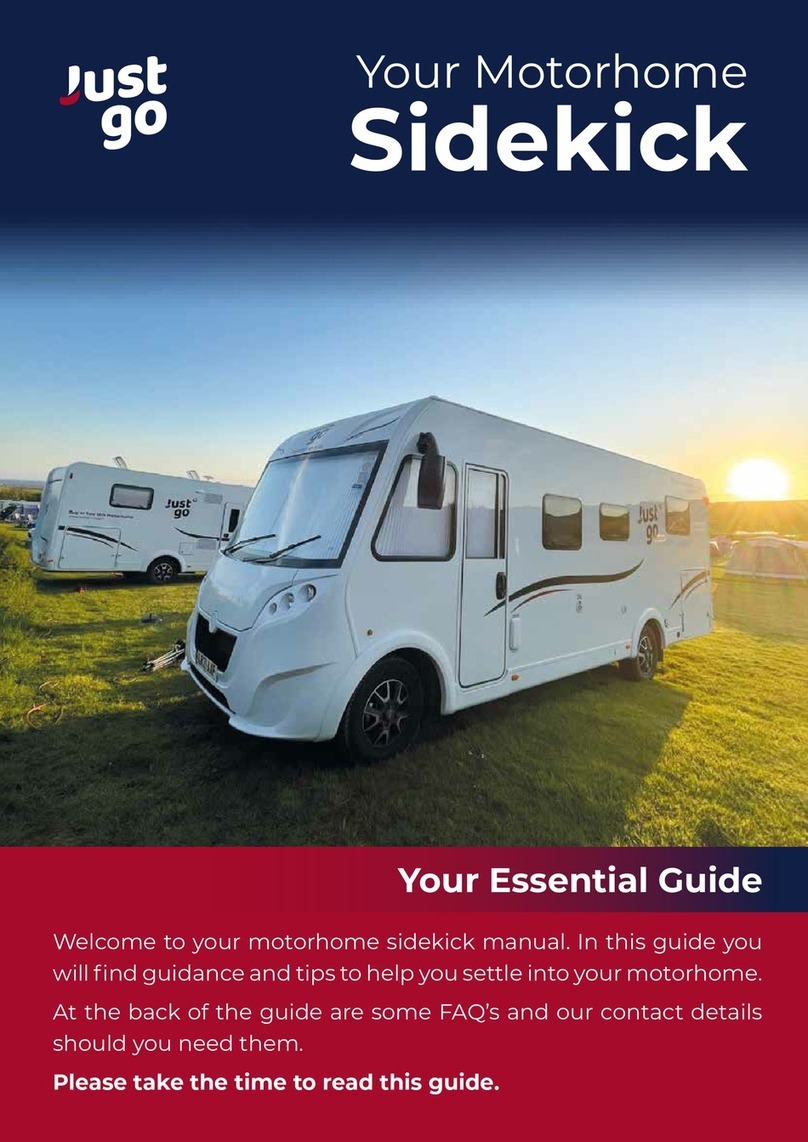
Just Go
Just Go Sidekick 2021 ESSENTIALS GUIDE
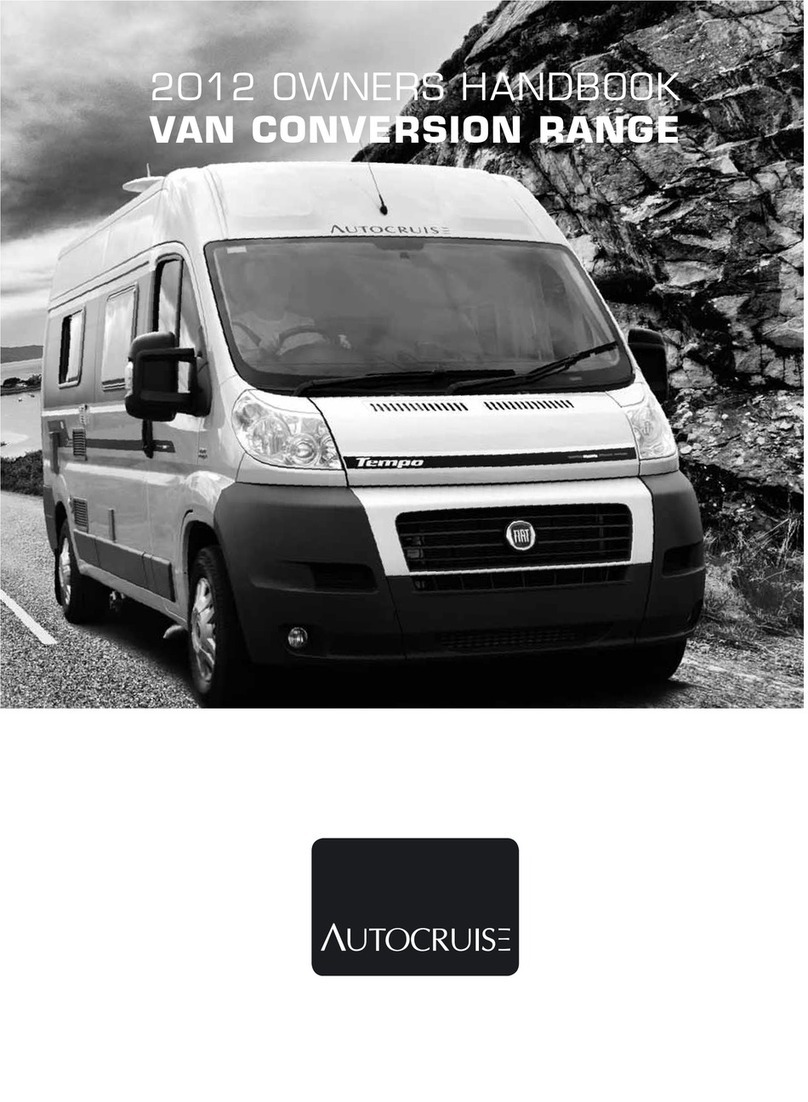
Autocruise
Autocruise 2012 Van Conversion Range Owner's handbook

Winnebago
Winnebago Minnie Winnie Premier owner's manual
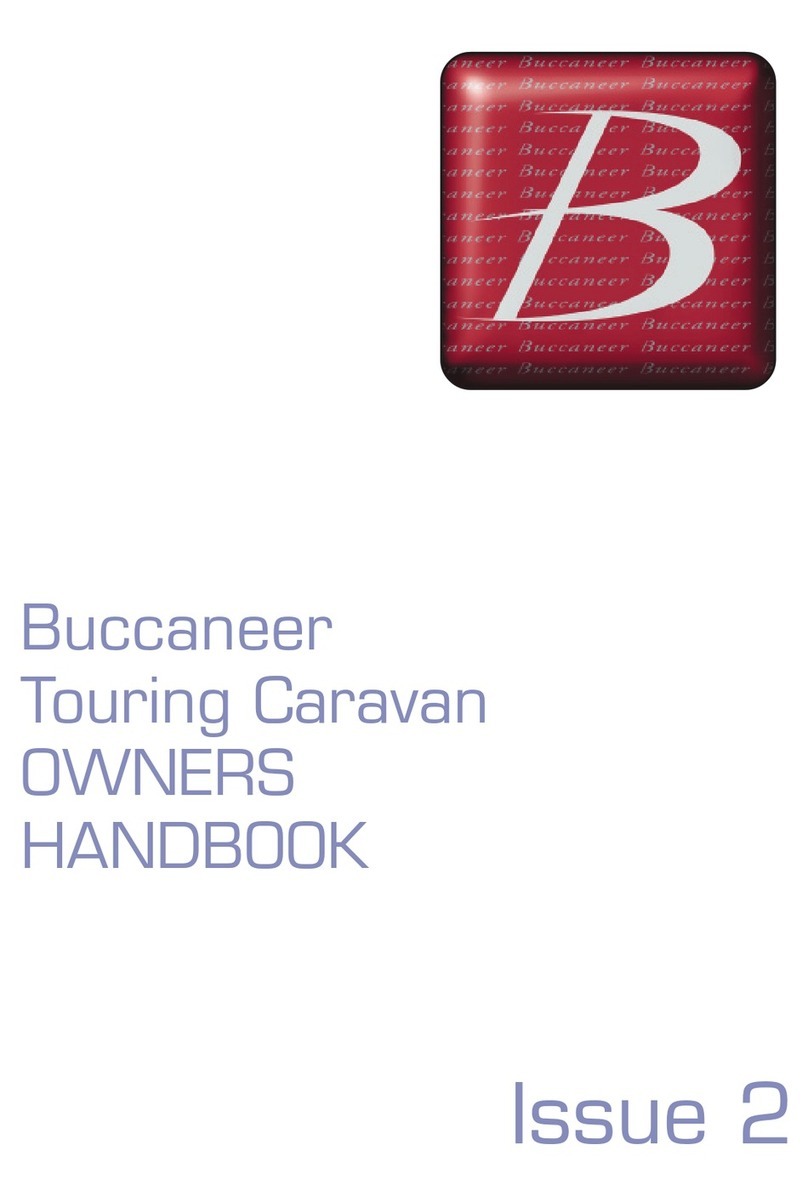
elddis
elddis Buccaneer Owner's handbook
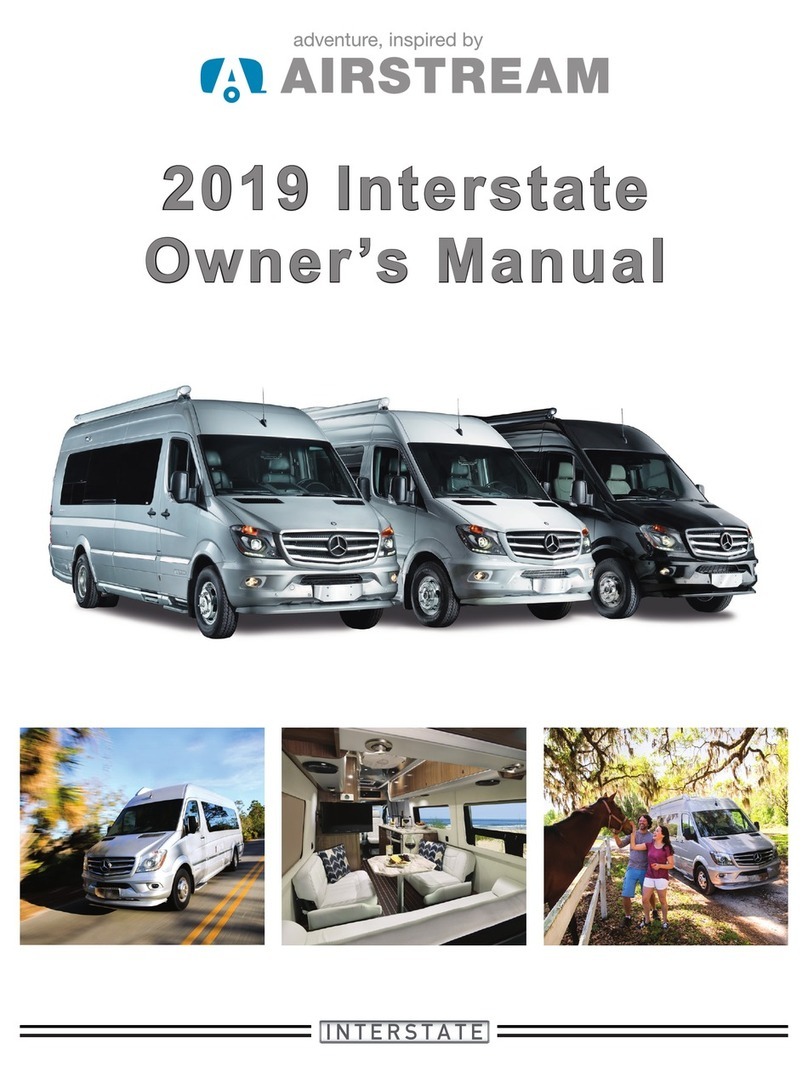
Airstream
Airstream Interstate 2019 owner's manual
